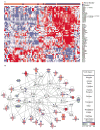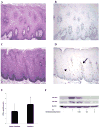Effects of cigarette smoke on the human oral mucosal transcriptome
- PMID: 20179299
- PMCID: PMC2833216
- DOI: 10.1158/1940-6207.CAPR-09-0192
Effects of cigarette smoke on the human oral mucosal transcriptome
Abstract
Use of tobacco is responsible for approximately 30% of all cancer-related deaths in the United States, including cancers of the upper aerodigestive tract. In the current study, 40 current and 40 age- and gender-matched never smokers underwent buccal biopsies to evaluate the effects of smoking on the transcriptome. Microarray analyses were carried out using Affymetrix HGU133 Plus 2 arrays. Smoking altered the expression of numerous genes: 32 genes showed increased expression and 9 genes showed reduced expression in the oral mucosa of smokers versus never smokers. Increases were found in genes involved in xenobiotic metabolism, oxidant stress, eicosanoid synthesis, nicotine signaling, and cell adhesion. Increased numbers of Langerhans cells were found in the oral mucosa of smokers. Interestingly, smoking caused greater induction of aldo-keto reductases, enzymes linked to polycyclic aromatic hydrocarbon-induced genotoxicity, in the oral mucosa of women than men. Striking similarities in expression changes were found in oral compared with the bronchial mucosa. The observed changes in gene expression were compared with known chemical signatures using the Connectivity Map database and suggested that geldanamycin, a heat shock protein 90 inhibitor, might be an antimimetic of tobacco smoke. Consistent with this prediction, geldanamycin caused dose-dependent suppression of tobacco smoke extract-mediated induction of CYP1A1 and CYP1B1 in vitro. Collectively, these results provide new insights into the carcinogenic effects of tobacco smoke, support the potential use of oral epithelium as a surrogate tissue in future lung cancer chemoprevention trials, and illustrate the potential of computational biology to identify chemopreventive agents.
Figures


Comment in
-
Upper airway gene expression in smokers: the mouth as a "window to the soul" of lung carcinogenesis?Cancer Prev Res (Phila). 2010 Mar;3(3):255-8. doi: 10.1158/1940-6207.CAPR-10-0013. Epub 2010 Feb 23. Cancer Prev Res (Phila). 2010. PMID: 20179303
References
-
- Gritz ER, Dresler C, Sarna L. Smoking, the missing drug interaction in clinical trials: ignoring the obvious. Cancer Epidemiol Biomarkers Prev. 2005;14:2287–93. - PubMed
-
- Hecht SS. Tobacco carcinogens, their biomarkers and tobacco-induced cancer. Nat Rev Cancer. 2003;3:733–44. - PubMed
-
- Mayne ST, Lippman SM. Cigarettes: a smoking gun in cancer chemoprevention. J Natl Cancer Inst. 2005;97:1319–21. - PubMed
-
- The -Tocopherol, β Carotene Cancer Prevention Study Group. The effect of vitamin E and β carotene on the incidence of lung cancer and other cancers in male smokers. N Engl J Med. 1994;330:1029–35. - PubMed
Publication types
MeSH terms
Substances
Grants and funding
LinkOut - more resources
Full Text Sources
Other Literature Sources
Molecular Biology Databases

